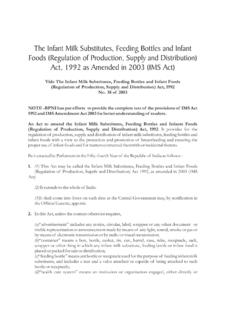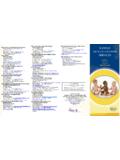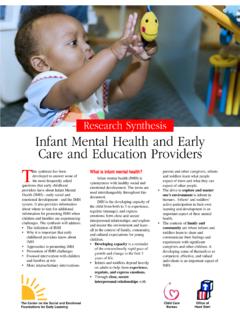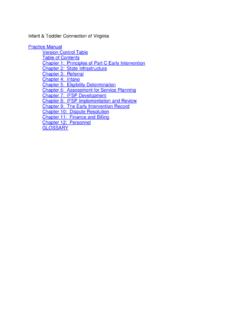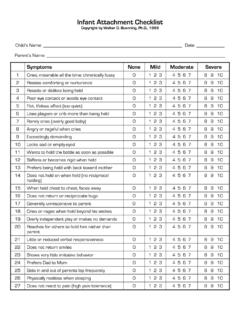Transcription of THE FAGAN TEST OF INFANT INTELLIGENCE
1 THE FAGAN TEST OF INFANT INTELLIGENCE MANUAL Joseph F. FAGAN , III, Leffingwell Professor Department of Psychology Case Western Reserve University Cleveland, Ohio 44106-7123 Office: (216) 368-6476 FAX: (216) 368-4891 Email: @1985, 1991, 2005, Joseph F. FAGAN , III, The FAGAN Test of INFANT INTELLIGENCE - Manual 1 Table of Contents The FAGAN Test of INFANT INTELLIGENCE : A Technical Equipment Training for the FAGAN Test of INFANT Care of Space Testing Time Arranging Equipment for a Conducting the Clinical Administering the Viewing and Printing the Data.
2 35 Testing Recording Background Establishing and Maintaining Parent Testing Administrator Testing Behavior ..44 Conducting the Test: An Closing Appendix A: Testing Appendix B: Picture Testing List ..49 Appendix C: Test Scheduling Appendix D: Sample Data Appendix E: Background Information Appendix F: License The FAGAN Test of INFANT INTELLIGENCE - Manual 2 Introduction Achieving the prediction of later intellectual ability from infancy has challenged investigators for over 50 years. On standard INTELLIGENCE tests , children are asked to encode and retain new information, to categorize stimuli, and to retrieve useful information.
3 Methodological advances in the field of INFANT visual perception and recognition memory have made it possible to show that the INFANT is capable of encoding, retaining, categorizing, and retrieving visual information. Intelligent activity in the INFANT as indexed by visual information processing can be measured and is, in fact, predictive of later intellectual performance. The FAGAN Test of INFANT INTELLIGENCE (FTII) is the culmination of 20 years of basic research on INFANT visual perception and recognition memory abilities and 10 years spent developing a clinically useful test for diagnosing infants at high-risk for later intellectual deficit.
4 The FAGAN Test of INFANT INTELLIGENCE is the first commercially available test that predicts later intellectual performance for high-risk infants at an acceptable level of accuracy. The advantages of the FAGAN test of INFANT INTELLIGENCE go beyond simply assessing cognitive normality or deficit for high-risk infants. As a research instrument, the FAGAN Test of INFANT INTELLIGENCE offers the possibility of eventually understanding the causes of mental retardation in high-risk infants, causes that are evident during infancy. More importantly for those who care for infants, use of the FAGAN Test of INFANT INTELLIGENCE means that the parents of the majority of high-risk infants can be spared several years of anxiety and encouraged to treat their infants as intellectually normal.
5 Those parents of high-risk infants identified by the FAGAN Test of INFANT INTELLIGENCE as suspect for mental retardation can be encouraged to seek intervention programs to alleviate the effects of the deficit. Although the FAGAN Test of INFANT INTELLIGENCE has behind it several years of systematic study, research does and will continue. You, as an administrator of the FAGAN Test, may participate in that research by sharing your observations with us. With the data obtained, we will be able to further refine the test and increase our knowledge about the causes of and, we hope, the remedies for mental retardation.
6 The FAGAN Test of INFANT INTELLIGENCE - Manual 3 The Manual details the data in support of the FAGAN Test of INFANT INTELLIGENCE , and presents the information you will need to correctly administer the test to high-risk infants. You are encouraged to contact us with your questions about the test itself, or about test administration. We also welcome your suggestions on how to improve any aspect of the test. We appreciate your using the FAGAN Test of INFANT INTELLIGENCE as a clinical tool in your evaluation of infants and we are here to facilitate your use of the test and in any way that we can.
7 The FAGAN Test of INFANT INTELLIGENCE - Manual 4 The FAGAN Test of INFANT INTELLIGENCE : A Technical Summary Published in the Journal of Applied Developmental Psychology 13, 173-193 (1992) The article, by Joseph F. FAGAN III and Douglas K. Detterman, summarizes data on the psychometric properties of the FAGAN Test of INFANT INTELLIGENCE . The FAGAN & Detterman article is presented here, in edited form, to serve as an introduction to the FAGAN Test. Following a brief discussion of the empirical basis of the FAGAN test, a note on the theoretical rationale underlying the test, and a summary of the development of the test, the FAGAN test is presented including a description of the FAGAN test, data and discussions on reliability, validity, and clinical utility, and notes on issues such as cross-cultural utility.
8 The discussion concludes with a section on practical implications raised by the transfer of the FAGAN test to professionals who are interested in high-risk infants. The empirical basis for the FAGAN Test of INFANT INTELLIGENCE rests on the fact that individual differences in the processing of information during infancy are linked to individual differences in performance on standard tests of INTELLIGENCE later in life. A basic measure of the processing of information is the tendency of the INFANT to look longer at a new target than at one previously seen ( FAGAN , 1970).
9 Studies of the INFANT s preference for novelty have shown that the abstraction of information is a robust phenomenon during infancy. tests of visual novelty preference tell us that the INFANT has the ability to know the world. If such processes of knowledge acquisition underlie performance on INTELLIGENCE tests later in life, it is justifiable to assume that their exercise early in life represents intelligent activity on the part of the INFANT . Hence, it comes as no surprise to find that measures of visual novelty preference derived during infancy are related to later intellectual functioning.
10 Various meta-analyses (Bornstein & Sigman, 1986; FAGAN & Singer, 1983) have found median correlations of about .45 between INFANT performance and later IQ. Studies employing more tests of visual novelty preferences and/or sampling from populations with a wider range of IQ have yielded somewhat higher correlations between early novelty preferences and later IQ. FAGAN and Montie (1988) report a correlation of .49 between a test of 12 visual novelty problems administered to 128 children between 3-7 months and scores on standard INTELLIGENCE tests at 3 years (IQ range = 25-135).
